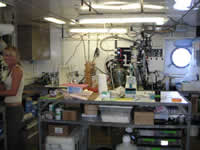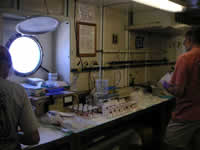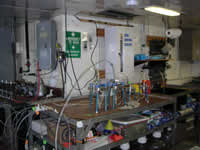


|
The Project Part 1: Part 2: Part 3:
|
25 July, 2005
The scientists continue to prepare their equipment for the experiments to be conducted in the Gulf of California. Another practice run was made with the CTD and everything went smoothly. The scientists also met today to tweak the sampling schedule when we get to the Gulf; there’s a lot to be done there that involves different experiments. The ship is about 3 hours behind schedule, but we are on course to make it up. The ship is now 38 miles off the Baja California coast because there are shoals nearer to shore. Shoals are sandbars or sandbanks that create shallow waters that are hazardous to ships. The color of the ocean has changed dramatically since leaving port. On our run from San Diego, the waters were greenish, signifying a rich nutrient composition. Today it is a deep blue, “a washtub bluing blue, intense and seeming to penetrate deep into the water” (The Log from the Sea of Cortez). This deep blue color means that there is less phytoplankton and therefore less food for all the critters that eat it, and thus for the critters that feed on them. We are cruising through an oligotrophic area, an area deficient in plant nutrients. Perhaps that is why we have seen no wildlife today. The root word “olig” comes to us from the Greeks. It means “few.” If “–archy” means government in Greek, what is the definition of oligarchy? Math Problem: We are traveling at a speed of 11 knots per hour. A knot is equal to 1.15 miles per hour. How fast are we traveling per hour? Yesterday, during a 24 hour period, the New Horizon traveled 232.8 miles. The ship consumed 1200 gallons of diesel fuel. How many miles per gallon is that? Trivia Tidbit of the Day Where did the word California come from? According to John Steinbeck in The Log from the Sea of Cortez, there are a couple of versions that account for the possible origins of the word California. Hernan Cortés, the Spanish conqueror of Mexico, explored the Baja coast in 1535-36. Cortés, who “pretended to have knowledge of Latin,” may have named the Baja Peninsula “Callida fornax” (high temperature) because the heat was so strong. Another version recounts a sighting by Cortés of a small cove at the Cape of San Lucas. A small cove in Spanish is cala (or caleta). Fornix means arch in Latin. Cortés saw a rock arch in the cove and by mixing Spanish and Latin came up with Cala y fornix. Yet another similar version combines “cala” (cove) and “fornax” (heat in Latin). Steinbeck warns us that perhaps none of these versions are correct, but “if this conjecture be not true, it is at least credible.”
|




